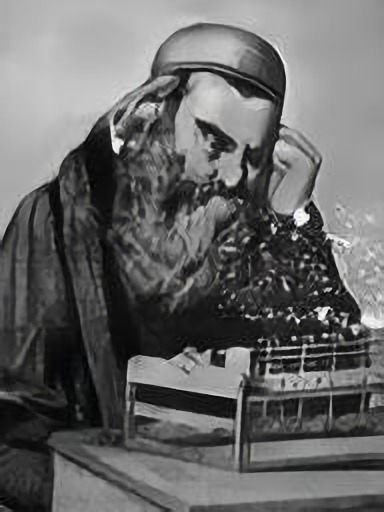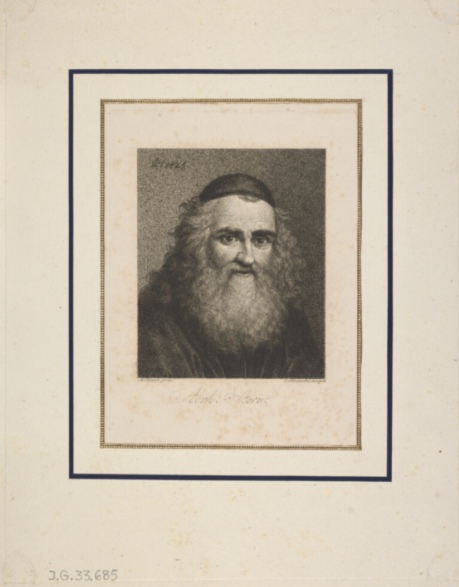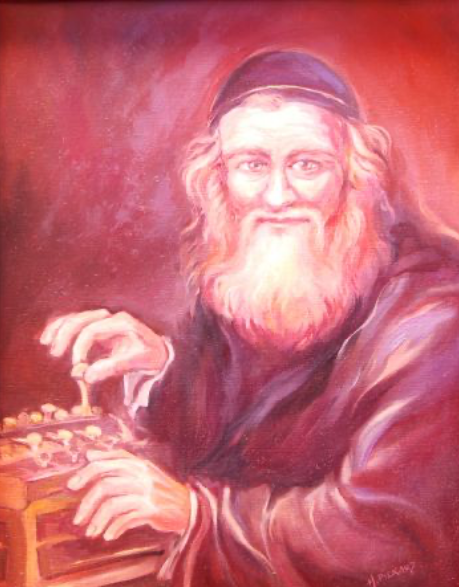Most probably he was born in 1769 in Hrubieszów - a town in south-eastern Poland - as one of two sons of Menechem Mendel Stern and Mirian Stern. The family was poor and the future of the boys uncertain; Abraham was sent for upbringing and education to a local watchmaker. Meanwhile, Stanisław Wawrzyniec Staszic - a leading figure in the Polish Enlightenment, a priest, philosopher, writer, translator, geologist and statesman - bought an estate in Hrubieszów and Abraham Stern was lucky enough to get noticed by Staszic.
The history is rather unusual as Stanisław Staszic was notorious for his aversion to Jews, yet regardless of that he took care of Abraham and made his talents bloom. In 1811 Staszic took Abraham to Warsaw, where he continued working on his inventions.
As early as 3 November 1811, Stern participated for the first time in a meeting of the Warsaw Society of the Friends of Science.
The first of his known inventions was the
„Movable Topographic Machine”,
which was a kind of target maker. The Illustrated Weekly of 25 June 1864 says it was "equipped with two pointers, suited for engineers and artillerymen to replace an inconvenient measuring table (...)".
Another Stern’s innovation for geodetic purposes was a
topographical horse cart,
which was designed to draw the geological situation and profile of the terrain at the same time and on any scale.
Yet, his most important invention was undoubtedly the
The latest version from 1817 could perform
tasks like adding, subtracting, multiplying, dividing
and calculating an nth root of a natural number. In addition,
unlike previous machines of this type, the Stern’s tool
was accurate, sturdy and - above all - simple to use.

This invention made him famous; he joined the Warsaw Society of the Friends of Science as a Correspondent Member on February 9th, 1817. On February 4th, 1821 he became an Accepted Member of the Society, then on January 1st an Active Member of the Society of the Friends of Science. Stern's accounting machine was even appreciated by Tsar Alexander I, who granted him a governmental scholarship for further improvements.
Not only was Stern a genius inventor but also sagacious in human sciences. He was the first Rector of the Warsaw School of Rabbis and Chairman of the Censorship Committee of Hebrew books and writings. Apart from numerous works on his own inventions, he is an author of many essays in Hebrew. Moreover, in 1823 in the "Warsaw Diary" he translated a piece originally written by Natan Moskwicz Hanowerski in Hebrew and published under the title "Description of Ukrainian Revolts".
Next to the accounting machine he also invented
a mechanical thresher, a sawmill, a horse drawn harvester and a mechanism for carriages to prevent horses from scattering.
His inventions were ahead of his own time and despite their practical value they could hardly find any wide industrial application.
Stern died on 2 February 1842 in the house 1063 on Królewska Street in Warsaw. He was buried on February 4th at the Jewish Cemetery in Warsaw's Bródno district.
jako mędrzec zasiadał między
uczonymi, obcując
jednocześnie z pobożnymi
i szlachetnymi swego narodu.
W ubóstwie pracował
wszystkie dni swego życia,
był piękną koroną i podporą
swej gminy.

Abraham Stern was married to Shaindla Lipshitz with at least nine children: Ber Stern, Ha Cohen; Sara Gitel Słonimska; Esther Stern; Isaac Stern; Eliezer Stern; Hanoch Stern; Idla Stern; Jacob Stern and Rachel Stern.

To this day merely a few works with Abraham Stern’s image have survived. Probably the most famous of them is his portrait by Antoni Blank from 1823, which is currently exhibited in the National Museum in Poznan.
Two more quite well-known bodies of work with Stern’s image, namely a print of Jan Feliks Piwarski.


and a woodcut of Abraham Stern à Varsovie of an unknown author from "L'Illustration, Journal Universel" (Paris, around 1860), should not remain unmentioned.
Concerning contemporary works of art in 2011 Helena Piekarz painted the "Portrait of Abraham Stern”, which is currently exhibited in the Stanisław Staszic Museum in Hrubieszów.

To this day merely a few works with Abraham Stern’s image have survived. Probably the most famous of them is his portrait by Antoni Blank from 1823, which is currently exhibited in the National Museum in Poznan.

Two more quite well-known bodies of work with Stern’s image, namely a print of Jan Feliks Piwarski.

and a woodcut of Abraham Stern à Varsovie of an unknown author from "L'Illustration, Journal Universel" (Paris, around 1860), should not remain unmentioned.

Concerning contemporary works of art in 2011 Helena Piekarz painted the "Portrait of Abraham Stern”, which is currently exhibited in the Stanisław Staszic Museum in Hrubieszów.




